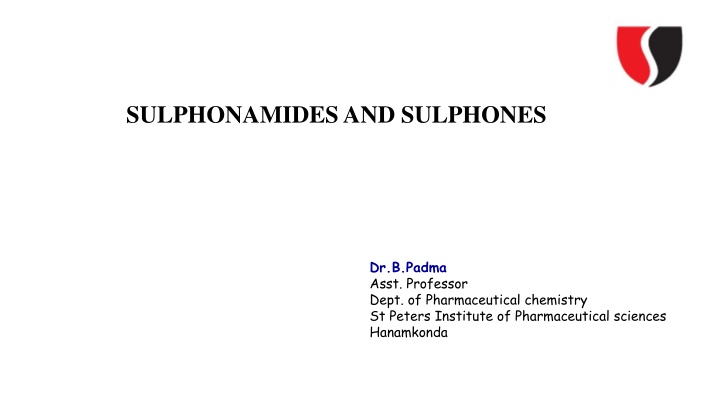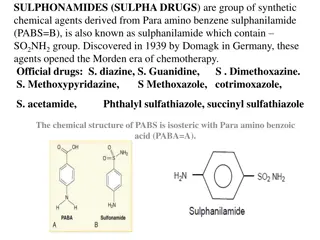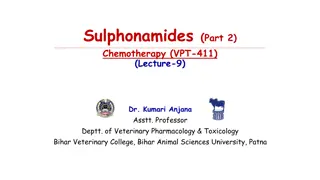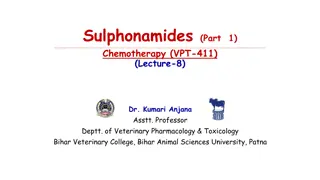
Understanding the Classification of Sulphonamides in Pharmaceutical Chemistry
Explore the classification of sulphonamides based on various criteria like site of action, pharmacokinetic properties, pharmacological activity, and duration of action. Learn about the different types of sulphonamides and their applications in pharmaceutical sciences.
Download Presentation

Please find below an Image/Link to download the presentation.
The content on the website is provided AS IS for your information and personal use only. It may not be sold, licensed, or shared on other websites without obtaining consent from the author. If you encounter any issues during the download, it is possible that the publisher has removed the file from their server.
You are allowed to download the files provided on this website for personal or commercial use, subject to the condition that they are used lawfully. All files are the property of their respective owners.
The content on the website is provided AS IS for your information and personal use only. It may not be sold, licensed, or shared on other websites without obtaining consent from the author.
E N D
Presentation Transcript
SULPHONAMIDES AND SULPHONES Dr.B.Padma Asst. Professor Dept. of Pharmaceutical chemistry St Peters Institute of Pharmaceutical sciences Hanamkonda
SULPHONAMIDES AND SULPHONES Introduction Sulfonamides (Sulphonamides) are a group of man-made (synthetic) medicines that contain the sulfonamide chemical group. They may also be called sulfa drugs. - Some sulfonamides are also devoid of antibacterial activity, e.g., the anticonvulsant (Sultiame). The sulfonylureas and thiazide diuretics are newer drug groups based upon the antibacterial sulfonamides. - The first sulfonamide was trade named Prontosil, which is a prodrug Prontosil, the first commercially available antibacterial with a relatively broad effect (against Gram-positive cocci but not against enterobacteria).
Sulphonamides can be classified in a variety of ways: 1. On the basis of the site of action (i)Sulphonamides for general infection: Sulphanilamide, Sulphapyridine, Sulphadiazine, Sulphamethoxacine, Sulphamethoxazole. (ii) Sulphonamides for urinary tract infections: Sulphaisoxazole, Sulphathiazole. (iii) Sulphonamides for intestinal infections: Phthalylsulphathiazole, Succinyl sulphathiazole, Sulphasalazine. (iv) Sulphonamides for local infections: Sulpahacetamide, Mafenamide, Silver sulphadiazine. (v) Sulphonamides for dermatitis: Dapsone, Solapsone. (vi) Sulphonamides in combination: Trimethoprim with Sulphamethoxazole.
2. On the basis of the pharmacokinetic properties (i) Poorly absorbed sulphonamides (locally acting sulphonamides): Sulphasalazine, Phthalylsulphathiazole, Sulphaguanidine, Salicylazo sulphapyridine, Succinyl sulpha thiazole. (ii) Rapidly absorbed and rapidly excreted (systemic sulphanamides): Sulphamethoxazole, Sulphaisoxazole, Sulphadiazine, Sulphadimidine, Sulphafurazole, Sulphasomidine, Sulphamethiazole, Sulphacetamide Sulphachlorpyridazine. (iii) Topically used sulphonamides: Sulphacetamide, Mafenide, Sulphathiazole, Silver sulphadiazine.
3. On the basis of the pharmacological activity (i) Antibacterial agents: Sulphadiazine, Sulfi soxazole. (ii) Drugs used in dermatitis: Dapsone. 4. On the basis of the duration of action (i) Extra-long-acting sulphonamides (half-life greater than 50 h): Sulphasalazine, Sulphaclomide, Sulphalene. (ii) Long-acting sulphonamides (half-life greater than 24 h): Sulphadoxine, Sulphadimethoxine, Sulphamethoxy pyridazine, Sulphamethoxydiazine, Sulphaphenazole, Sulphamethoxine. (iii) Intermediate-acting sulphonamides (half-life between 10 24 h): Sulphasomizole, Sulphamethoxazole. (iv) Short-acting sulphonamides (half-life less than 20 h): Sulphamethiazole, sulphaisoxazole. (v) Injectable (soluble sulpha drugs): Sulphafurazole, Sulphadiazine, Sulphamethoxine.
5. On the basis of the chemical structure (i) N-1 substituted sulphonamide: Sulphadiazine, Sulphacetamide, Sulphadimidine. (ii) N-4 substituted sulphonamides (prodrugs): Prontosil. (iii) Both N-1 and N-4 substituted sulphonamides: Succinyl sulphathiazole, Phthalylsulphathiazole. (iv) Miscellaneous: Mefenide sodium.
SAR of Sulphonamides The major features of SAR of sulphonamides include the following: Sulphanilamide skeleton is the minimum structural requirement for antibacterial activity. The amino- and sulphonyl-groups on the benzene ring are essential and should be in 1 and 4 position. The N-4 amino group could be modified to be prodrugs, which are converted to free amino function in vivo
Sulphur atom should be directly linked to the benzene ring. - Replacement of benzene ring by other ring systems or the introduction of additional substituents on it decreases or abolishes its activity - Exchange of the SONH by CONH reduces the activity - On N-1-substituted sulphonamides, activity varies with the nature of the substituent at the amino group. With substituents imparting electron-rich characters to SO group, bacteriostatic activity increases. - Heterocyclic substituents lead to highly potent derivatives, while sulphonamides, which contain a single benzene ring at N-1 position, are considerably more toxic than heterocyclic ring analogues - The free aromatic amino groups should reside para to the sulphonamide group. Its replacement at ortho or meta position results in compounds devoid of antibacterial activity. - The active form of sulphonamide is the ionized, maximum activity that is observed between the pKa values 6.6 7.4.
Substitutions in the benzene ring of sulphonamides produced inactive compounds. - Substitution of free sulphonic acid ( SO3H) group for sulphonamido function destroys the activity, but replacement by a sulphinic acid group ( SO2H) and acetylation of N-4 position retains back the activity - Meta-Sulphonamides bind to the basic centres of arginine, histidine, and lysine sites of proteins. binding groups are alkyl, alkoxy, and halides. The binding affects the activity of sulphonamides; protein protein binding appears to modulate the availability of the drug and its half-life. - The lipid solubility influences the pharmacokinetic and antibacterial activity, and so increases the half life and antibacterial activity
group for sulphonamido function destroys the activity, but replacement by a sulphinic acid group ( SOH) and acetylation of N-4 position retains back the activity. - Meta-Sulphonamides bind to the basic centres of arginine, histidine, and lysine sites of proteins. binding groups are alkyl, alkoxy, and halides. The binding affects the activity of sulphonamides; protein binding appears to modulate the availability of the drug and its half-life. - The lipid solubility influences the pharmacokinetic and antibacterial activity, and so increases
Mechanism of action: Sulfonamides & Trimethoprim - Sulfanilamide is a competitive inhibitor of bacterial enzyme dihydropteroate synthetase. This enzyme normally uses para-aminobenzoic acid (PABA) for synthesizing the necessary folic acid. The inhibited reaction is normally necessary in these organisms for the synthesis of folic acid. Without it, bacteria cannot replicate. - Trimethoprim is a reversible inhibitor of dihydrofolate reductase, one of the principal enzymes catalyzing the formation of tetrahydrofolic acid (THF) from dihydrofolic acid (DHF). Tetrahydrofolic acid is necessary for the biosynthesis of bacterial nucleic acids and proteins and ultimately for continued bacterial survival-inhibiting its synthesis, then, results in bactericidal activity. Trimethoprim binds with a much stronger affinity to bacterial dihydrofolate reductase as compared to its mammalian counterpart, allowing trimethoprim to selectively interfere with bacterial biosynthetic processes. - Trimethoprim exerts a synergistic effect with sulfonamides.
Trimethoprim is often given in combination with sulfamethoxazole, which inhibits the preceding step in bacterial protein synthesis-given together, sulfamethoxazole and trimethoprim inhibit two consecutive steps in the biosynthesis of bacterial nucleic acids and proteins. As a monotherapy trimethoprim is considered bacteriostatic, but in combination with sulfamethoxazole is thought to exert bactericidal activity
Side effects - Sulfonamides have the potential to cause a variety of untoward reactions, including urinary tract disorders, haemopoietic disorders, and hypersensitivity reactions. - When used in large dose, it may develop a strong allergic reaction. One of the most serious is Stevens Johnson syndrome (or toxic epidermal necrolysis). - Some of the original sulfonamide drugs were derived from azo dyes and had the interesting effect of temporarily turning the patient red. - N.B- Stevens-Johnson syndrome (SJS) is a life-threatening condition affecting the skin, in which due to cell death the epidermis separates from the dermis. The syndrome is thought to be a hypersensitivity
Adverse reactions i) The most common manifestation of a hypersensitivity reaction to sulfa drugs are rash and hives. However, there are several life-threatening manifestations of hypersensitivity to sulfa drugs, including Stevens-Johnson syndrome, toxic epidermal necrolysis, agranulocytosis, hemolytic anemia, thrombocytopenia, and fulminant hepatic necrosis, among others ii) The sulfonamide antibiotic chemical structures are implicated in the hypersensitivity reactions associated with the class. - The first is the N1 heterocyclic ring, which causes a type I hypersensitivity reaction. - The second is the N4 amino nitrogen that, in a stereospecific process, forms reactive metabolites that
Dapsone (DDS, Diaminodiphenyl sulphone) Mechanism of action - As an antibacterial, Dapsone inhibits bacterial synthesis of dihydrofolic acid, via competition with para-aminobenzoate for the active site of dihydropteroate synthase. Adverse effects - The most prominent side-effects of this drug are dose-related hemolysis (which may lead to hemolytic anemia) and methemoglobinemia. - Toxic hepatitis and cholestatic jaundice. - Other adverse effects include nausea, headache, and rash (which are common), and insomnia, psychosis, and peripheral neuropathy
Uses Dapsone is commonly used in combination with rifampicin and clofazimine for the treatment of leprosy It is also used to both treat and prevent pneumocystis pneumonia and toxoplasmosis. Dapsone by mouth was one of the first medications used to treat moderate to severe acne vulgaris and useful in the prevention of malaria Dapsone also used to treat Autoimmune disease (like Cutaneous lupus erythematosus, Idiopathic thrombocytopenic purpura, Chronic spontaneous urticaria, Relapsing polychondritis). Dapsone also used in treatment of Dermatitis herpetiformis and generalized granuloma annulare. Dapsone has been used as a monomer in the design of dye adsorbent polymers.
Trimethoprim/Sulphamethoxazole Uses Lung infections (pneumonia or PJP) caused by a bacterium called Pneumocystis jirovecii(previously P. carinii). It is used for skin infections, travellers diarrhoea, and cholera.Infections caused by a bacterium called Toxoplasma (toxoplasmosis).Urinary bladder or urinary tract infections (water infections) Respiratory tract infections such as bronchitis. Ear infections such as otitis media An infection called nocardiosis which can affect the lungs, skin and brain. It may be used both to treat and prevent pneumocystis pneumonia in people with HIV/AIDS It can be given by orally or intravenously. Side effects Nausea, vomiting, rash, and diarrhoea.
Sulphamethizole Cystitis, Genital tract inflammation, Gonorrhea, Nephritis, Prostatitis, Urinary Tract Infection and Vaginal Inflammation Sulphaisoxazole Urinary Tract Infections, Meningococcal Meningitis, Acute Otitis Media, Trachoma, Inclusion Conjunctivitis, Nocardiosis, Chancroid, Toxoplasmosis, Malaria and Other Bacterial Infections. Sulfamethazine For the treatment bacterial infections causing bronchitis, prostatitis, Bacterial Conjunctivitis, Endometritis, Furuncle, Streptococcal Sore Throat, Ulcers and Urinary Tract Infections. Sulfacetamide For the treatment of Bacterial Vaginitis, Keratitis, Acute Conjunctivitis, Acne Vulgaris, Conjunctivitis, Trachoma, Superficial Ocular Infections and Blepharitis. Sulphapyridine For the treatment of Dermatitis Herpetiformis, Benign Mucous Membrane Pemphigoid and Pyoderma Gangrenosum.
Sulphamethoxazole Sulfamethoxazole is indicated in combination with trimethoprim, in various formulations, for the following infections caused by bacteria with documented susceptibility: urinary tract infections, acute otitis media in pediatric patients (when clinically indicated), acute exacerbations of chronic bronchitis in adults, enteritis caused by susceptible Shigella, prophylaxis and treatment of Pneumocystis jiroveci pneumonia, and travelers' diarrhea caused by enterotoxigenic E. coli. Additional indications include the adjunctive treatment of cholera, treatment of bacillary dysentery, nocardiosis, and second-line treatment of brucellosis in combination with gentamicin or rifampicin. Sulphadiazine For the treatment of rheumatic fever, Nocardiosis, Plague, Plasmodium Infections, Toxoplasmosis, Trachoma, Urinary Tract Infection, Wound Infections, Bacterial otitis media caused by Haemophilus influenzae, Prophylaxis of Rheumatic fever Recurrent Rheumatic fever and meningococcal meningitis. Mafenide Indicated for use as an adjunctive topical antimicrobial agent to control bacterial infection when used under moist dressings over meshed autografts on excised burn wounds (Second Degree Burns and Third-Degree Burns). Sulfasalazine For the treatment of Crohn's disease, Crohn's Disease (CD), Polyarticular juvenile rheumatoid arthritis, chronic or unspecified, Proctitis, Rheumatoid Arthritis, Severe Ulcerative Colitis, Mild Ulcerative Colitis, Moderate Ulcerative colitis






